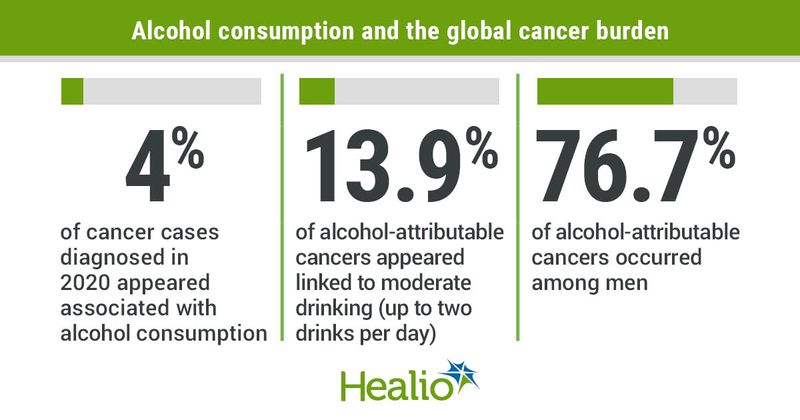Alcohol consumption linked to 4% of global cancer cases
Alcohol consumption appeared linked to more than 740,000 new cancer diagnoses in 2020, equivalent to 4% of cases worldwide.
Heavy alcohol consumption contributed to a high number of cancer cases, findings published in The Lancet Oncology showed. However, moderate drinking — defined as up to two alcoholic drinks per day — contributed to more than 103,000 cancer cases last year, or nearly 1 in 7 alcohol-associated malignancies.

Rumgay H, et al. Lancet Oncol. 2021;doi:10.1016/S1470-2045(21)00279-5.
“We urgently need to raise awareness about the link between alcohol consumption and cancer risk among policymakers and the general public,” Harriet Rumgay, BSc, doctoral student in cancer surveillance with International Agency for Research on Cancer, said in a press release. “Public health strategies — such as reduced alcohol availability, labeling alcohol products with a health warning, and marketing bans — could reduce rates of alcohol-driven cancer.
“Tax and pricing policies that have led to decreased alcohol intake in Europe, including increased excise taxes and minimum unit pricing, could also be implemented in other world regions,” Rumgay added. “Local context is essential for successful policy around alcohol consumption and will be key to reducing cancer cases linked to drinking.”
Prior research has established links between alcohol use and development of multiple cancers.
An American Cancer Society guideline that addressed how diet and physical activity can help prevent cancer recommended individuals not drink alcohol. Those who choose to consume alcohol should limit daily consumption — one drink for women and two drinks for men — guideline authors wrote.
Rumgay and colleagues conducted a population-based modeling study to provide global, regional and national estimates of the alcohol-attributable cancer burden in 2020 in hopes of informing alcohol policy and cancer control in various settings.
They used data on alcohol exposure from nearly all countries — both surveys and sales figures — as well as the most recent relative risk estimates for cancer based on alcohol consumption levels.
They calculated how various types of alcohol consumption — moderate (< 20 g, equivalent to about two drinks per day), risky (20 g to 60 g per day, equivalent to two to six drinks per day) or heavy (> 60 g per day, or more than six drinks) — contributed to the total alcohol-attributable cancer burden.
Rumgay and colleagues determined 741,300 (95% uncertainty interval [UI], 558,500-951,200) new cancer cases — 4.1% (95% UI, 3.1-5.3) of all newly diagnosed patients worldwide — were attributable to alcohol consumption.
Men accounted for more than three-quarters (76.7%; 95% UI, 422,500-731,100) of all alcohol-attributable cancer cases.
The most common malignancies included cancers of the esophagus (189,700 cases), liver (154,700 cases) and breast (98,300 cases).
Population-attributable fractions appeared highest in eastern Asia (5.7%; 95% UI, 3.6-7.9) and central/eastern Europe (5.6%; 95% UI, 4.6-6.6) and lowest in northern Africa (0.3%; 95% UI, 0.1-3.3) and western Asia (0.7%; 95% CI, 0.5-1.2). North America had the fourth-lowest population-attributable fraction of 17 regions assessed.
Heavy drinking accounted for the largest burden of alcohol-attributable cancers (46.7%; 95% UI, 227,900-489,400), followed by risky drinking (39.4%; 95% UI, 227,700-333,100) and moderate drinking (13.9%; 95% UI, 82,600-207,200).
The results demonstrate the need for interventions and effective policy to raise awareness about alcohol consumption’s effect on cancer risk, researchers concluded.
“Alcohol consumption causes a substantial burden of cancer globally,” Isabelle Soerjomataram, MD, PhD, MSc, deputy branch head of the cancer surveillance branch at International Agency for Research on Cancer, said in a press release. “Yet the impact on cancers is often unknown or overlooked, highlighting the need for implementation of effective policy and interventions to increase public awareness of the link between alcohol use and cancer risk, and decrease overall alcohol consumption to prevent the burden of alcohol-attributable cancers.”
Limitations of the data used in the analysis must be acknowledged, Amy C. Justice, MD, PhD, professor of medicine and professor of public health policy at Yale School of Medicine, wrote in an accompanying comment.
Approximately one-quarter of global alcohol consumption occurs outside government-controlled channels and, therefore, is not included in sales data, Justice wrote. Self-report also can underestimate alcohol use among heavy drinkers and those with health conditions that are exacerbated by alcohol use, she added.
“Furthermore, neither commercial sales nor current self-report reflect past alcohol consumption,” Justice wrote. “Past consumption has especially important implications for genetic studies typically including middle-aged and older participants, and for understanding associations between alcohol use and cancers that commonly have extended latency periods. In these settings, past consumption might be as influential as current use.”
Direct alcohol biomarkers are available. These include phosphatidylethanol, an abnormal phospholipid formed in the presence of ethanol. However, phosphatidylethanol is detectable only within 28 days of exposure.
“If repeated phosphatidylethanol measurement became routine over time, we could have a highly useful, individualized, accurate longitudinal measures of alcohol exposure — at least until longer-term direct biomarkers can be developed,” Justice wrote. “We do not ask people with diabetes what their glycosylated hemoglobin is, we check it. Then we discuss their risk of adverse health outcomes informed by the test results and their personal risk profile.”
A similar approach should be applied to counseling patients about risks of alcohol consumption, Justice wrote.
“Until we address limitations in measurement, we might be underestimating health risks — especially cancer risks — associated with alcohol,” she wrote .”This might be especially true among individuals who are most vulnerable. The sooner we start accurately measuring alcohol exposure, the sooner we can understand the true excess burden of cancer attributable to alcohol and effectively intervene.”

